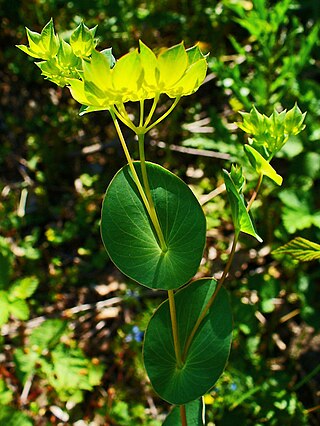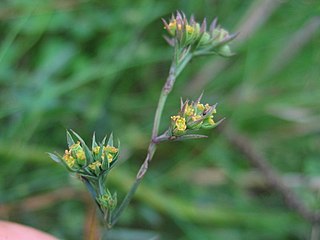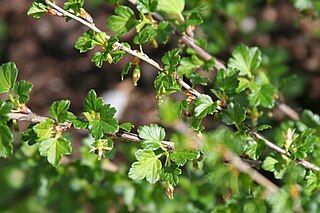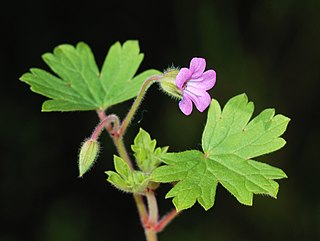
Eupatorium is a genus of flowering plants in the family Asteraceae, containing from 36 to 60 species depending on the classification system. Most are herbaceous perennials growing to 0.5–3 m (1.6–9.8 ft) tall. A few are shrubs. The genus is native to temperate regions of the Northern Hemisphere. Most are commonly called bonesets, thoroughworts or snakeroots in North America. The genus is named for Mithridates Eupator, king of Pontus.

Bupleurum is a large genus of annual or perennial herbs or woody shrubs, with about 190 species, belonging to the family Apiaceae. The full size of its species may vary between a few cm to up to 3 m high. Their compound umbels of small flowers are adorned with bracteoles that are sometimes large and may play a role in attracting pollinators. Rare among the Apiaceae are the simple leaves, bracts, and bracteoles. The genus is almost exclusively native in the Old World Northern Hemisphere, with one species native to North America and one species native to southern Africa.

Stylidium rotundifolium is a dicotyledonous plant that belongs to the genus Stylidium. It is an erect annual plant that grows from 4 to 18 cm tall. Obovate or oblanceolate leaves, about 4-17 per plant, form a basal rosette around the compressed stem. The leaves are generally 5–29 mm long and 3–10 mm wide. This species generally has one to ten scapes and cymose inflorescences that are 4–18 cm long. Flowers are pink or white. S. rotundifolium's wide, sporadic distribution ranges from the Kimberley region in Western Australia east to northeastern Queensland with a significant population near Taroom, Queensland. Its typical habitats include damp sandy soils on creekbanks, receding waterholes, or Melaleuca woodlands. It flowers in the southern hemisphere from April to October. S. rotundifolium is most closely related to S. dunlopianum.
NVC community CG1 is one of the calcicolous grassland communities in the British National Vegetation Classification system. It is one of three short-sward communities associated with heavy grazing, within the lowland calcicolous grassland group, and is regarded as the south-west coastal counterpart of "typical" chalk grassland.

Eupatorium rotundifolium, commonly called roundleaf thoroughwort, is a North American species of plant in the family Asteraceae. It native to the eastern and central United States, in all the coastal states from Maine to Texas, and inland as far as Missouri and the Ohio Valley. It is found in low, moist habitats such as wet savannas and bogs.

Bupleurum falcatum, also known as sickle-leaved hare's-ear, Chinese thoroughwax, sickle hare's ear and sickle-leaf hare's ear, is a species of flowering plant in the family Apiaceae.

Stugeta bowkeri, the Bowker's sapphire, Bowker's marbled sapphire or Bowker's tailed blue, is a butterfly of the family Lycaenidae. It is found in most of southern Africa.

Bupleurum tenuissimum, the slender hare's-ear, is a coastal plant of the family Apiaceae.
Bupleurum sintenisii is a species of flowering plant in the family Apiaceae. It is referred to by the common name dwarf hare's ear, and is an annual herb, 1–5 cm high, hairless and glaucous. Leaves alternate, simple, entire, linear, 10-20 x 0.5-1.5 mm. The inconspicuous flowers are yellowish to brownish and crowded in umbels. Flowers from May to July. The fruit is a dry schizocarp, covered by hooded bristles.

Ribes rotundifolium is a North American species of currant known by the common names wild gooseberry and Appalachian gooseberry. It is native to the eastern United States, primarily the Adirondacks, from Massachusetts and the Appalachian Mountains south as far as South Carolina and Tennessee.

Leptospermum rotundifolium, commonly known as round-leaved tea tree, is a species of flowering plants in the family Myrtaceae and is endemic to New South Wales, naturalised in Victoria and Western Australia. It is an erect shrub with more or less circular leaves but with a small point on the tip, and relatively large pink or white flowers.

Bupleurum fruticosum or shrubby hare's-ear is a species of flowering plant in the family Apiaceae. It is endemic to the Mediterranean region. It lives in sunny hills, walls and rocky places.
Rotundifoliusm., Rotundifoliaf. and Rotundifolium may refer to several plant species including:

Bupleurum baldense, the small hare's ear, is a plant species of the genus Bupleurum.

Leionema rotundifolium, is a dense shrub with needle-shaped stems and pale lemon to white terminal flowers. It is found in New South Wales and Queensland.

Euphorbia bupleurifolia, commonly known as cycad spurge or pine cone plant, is a species of plant in the family Euphorbiaceae.
Heldreichia is a monotypic genus of flowering plants belonging to the family Brassicaceae. The only species is Heldreichia bupleurifolia.
Bupleurum semicompositum, the dwarf hare's ear, is a species of annual herb in the family Apiaceae. They have a self-supporting growth form and simple, broad leaves and dry fruit. Individuals can grow to 0.3m tall.

Geranium rotundifolium, the roundleaf geranium, is a species of annual herb in the family Geraniaceae. They have a self-supporting growth form and are associated with freshwater habitat. They have simple, broad leaves, flowers are visited by sweat bees, Small Carpenter Bees, Myopa, and cabbage butterfly. Individuals can grow to 20 cm tall.

Bupleurum handiense, the Jandía anise, is a species of flowering plant in the Apiaceae family. It was described by Günther Willi Hermann Kunkel in 1976. It is endemic to the eastern Canary Islands, where it grows between 300 and 800 meters above sea level. It is classified by the IUCN Red List as endangered and it's primarily threatened by animal grazing.















